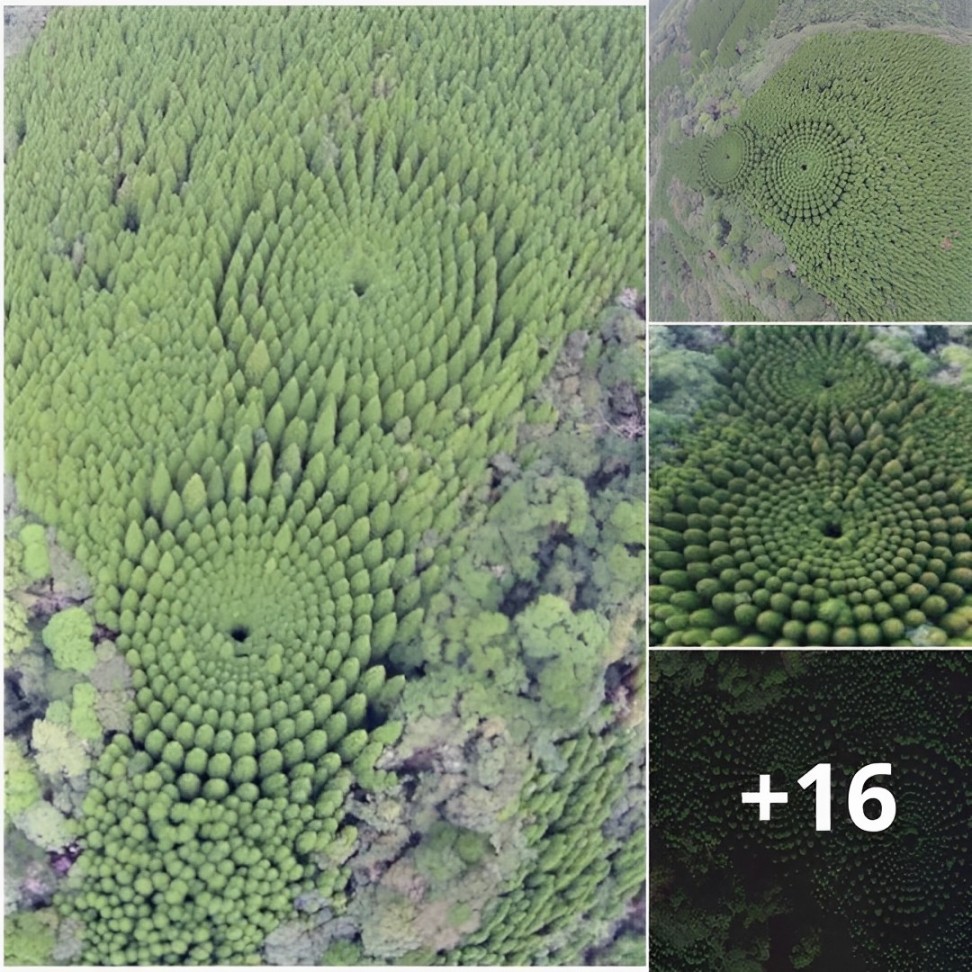I have by now written some 300 travel-blogs about different locations in Iceland, which I have visited all around my country, some in very remote areas.
I dedicated my last travel-blog to the Gullfoss waterfall – the Golden waterfall, which gives a name to the most popular route in Iceland; the Golden Circle. So I find it fitting to write about Geysir geothermal area now, as these 2 very popular sights are only 10 km apart, and are always visited together.
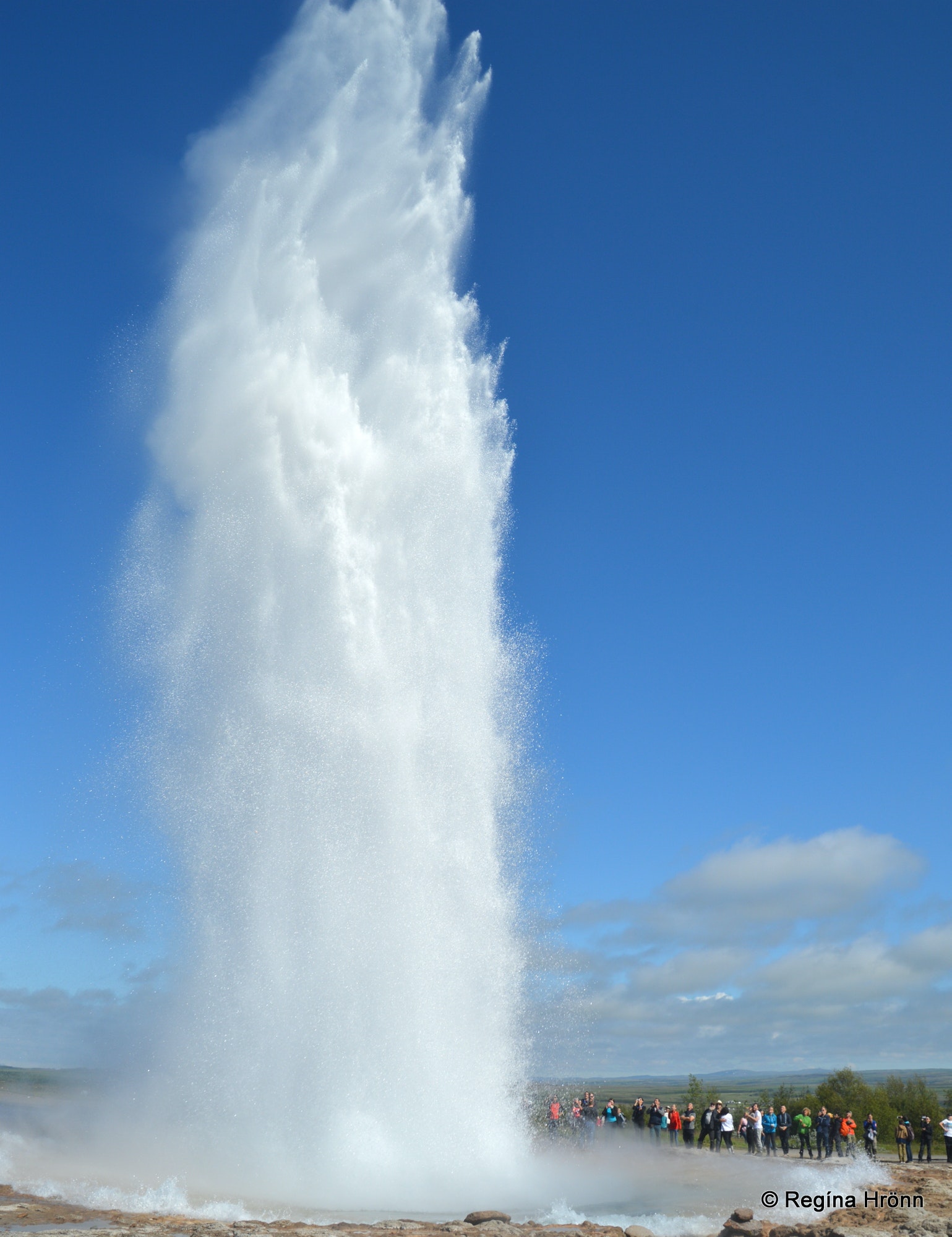
Strokkur erupting
The Geysir geothermal area is a big attraction on the Golden Circle, which traditionally includes Þingvellir national park, Geysir geothermal area, and Gullfoss waterfall (I also include Skálholt episcopal See).
I show all my foreign visitors these beautiful sights and I never tire of visiting them. I believe that most foreign visitors to my country visit the Golden Circle.
Apart from those who have only a few hours to spare while stopping over at the airport; they visit the Blue Lagoon.
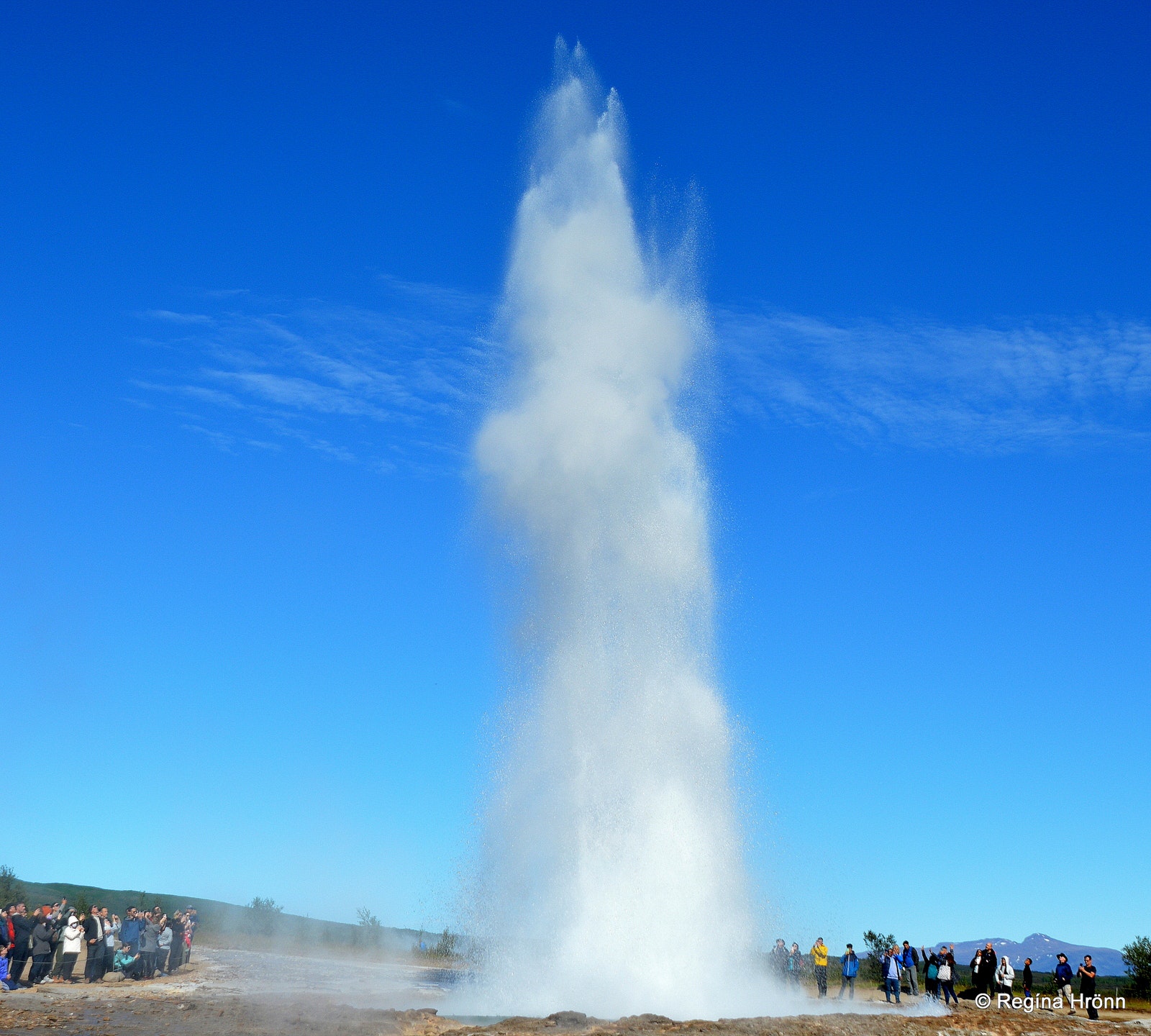
Strokkur erupting – it is at its most beautiful when the sky is blue and it doesn’t blend in with the clouds
In 2018 I took a group of 60 friends to Geysir and it was one of the worst days of the rainy summer of 2018 with warnings of swellings of rivers in the south! Bad luck, eh, as my friends missed the beautiful sight of seeing Strokkur erupting.
For obvious reasons (explained in the next chapter of this travel-blog) I have no photos of Geysir erupting, but I long to see it erupt. So all my photos of erupting geysers in my travel-blog are of Strokkur.
Geysir hot spring
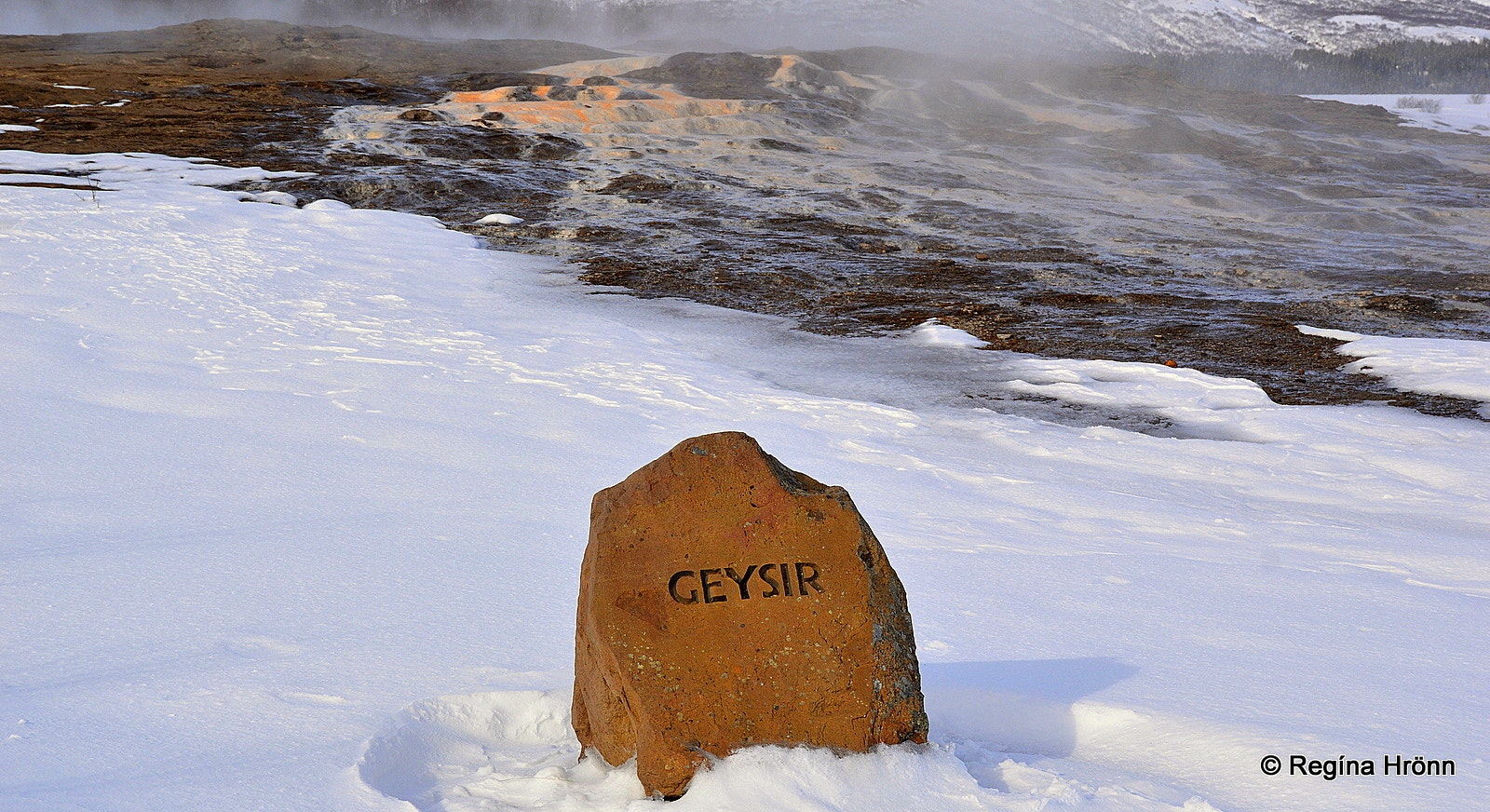
The original Geysir
The Geysir geothermal area is a well-known high-temperature geothermal area. And Geysir itself is one of the best-known geysers in the world and has given a name to other spouting hot springs around the world; geyser. In Icelandic, the term Geysir is derived from the verb gjósa, which means to erupt.
The Icelandic pronunciation of Geysir is like “hey!” while the English pronunciation is more like “hi” or “he”. You can hear the Icelandic pronunciation here.
Another word derived from the original Geysir is geyserite, as characteristic of the old Geysir is the huge geyserite which surrounds it.
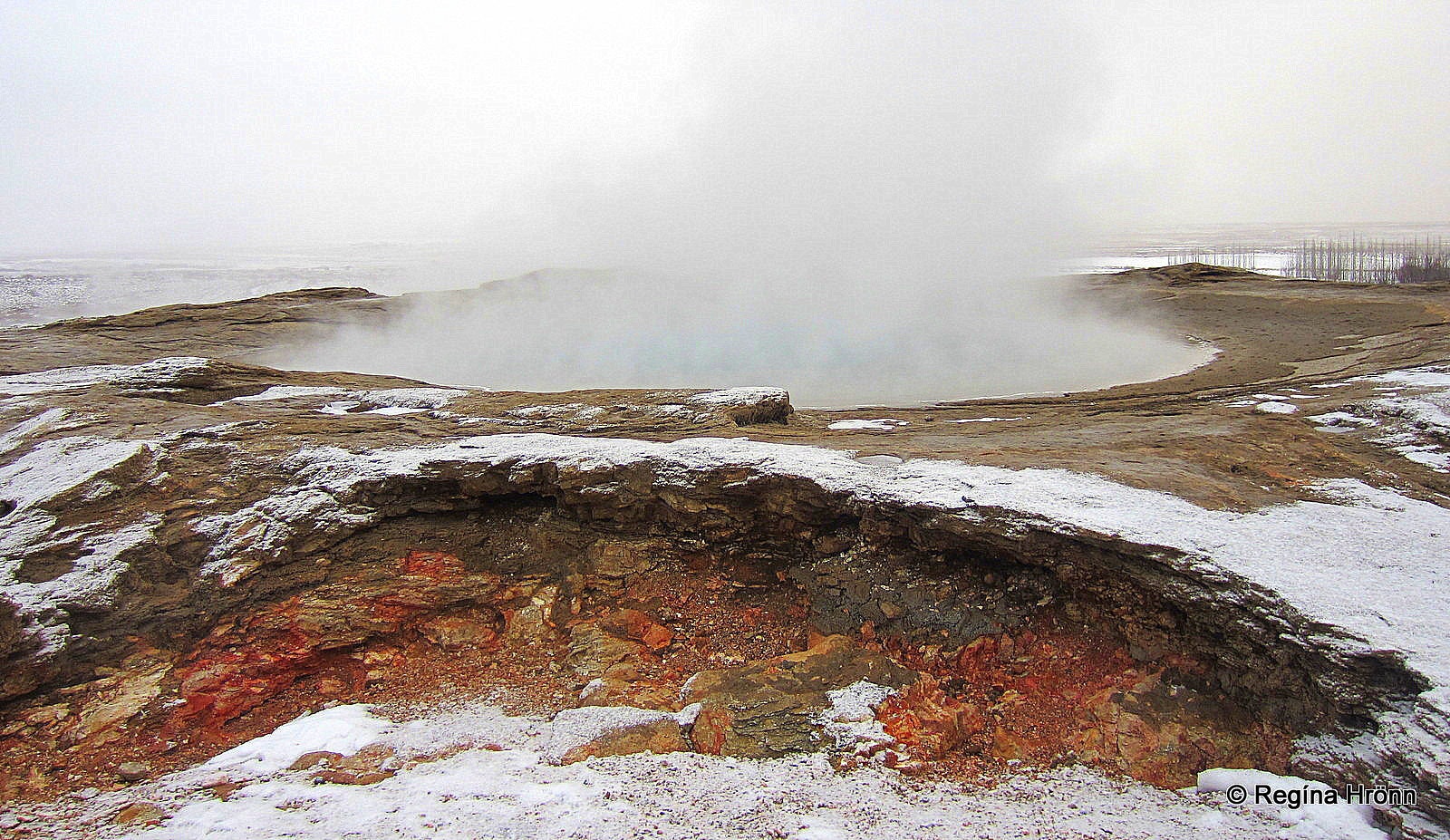 Geysir in the wintertime
Geysir in the wintertime
Geysir is almost dormant these days, but what you can see now when you visit the original Geysir is the 18 m in diameter bowl surrounded by thick geyserite (hverahrúður in Icelandic). The geyserites are among the most beautiful features of the geothermal areas in my opinion.
The shaft of the hot spring is around 20 m deep. It is difficult to get a decent photo of Geysir and the bowl as it is fenced off. And the Geysir geothermal area is a no-drone zone.
Geysir is believed to have started erupting after a big earthquake, Suðurlandsskjálftinn, in 1294. That is the first time this area was mentioned in written sources, Oddaverja annáll. But it might be much older or younger than that as the sources only mention that some hot springs disappeared and new ones appeared.
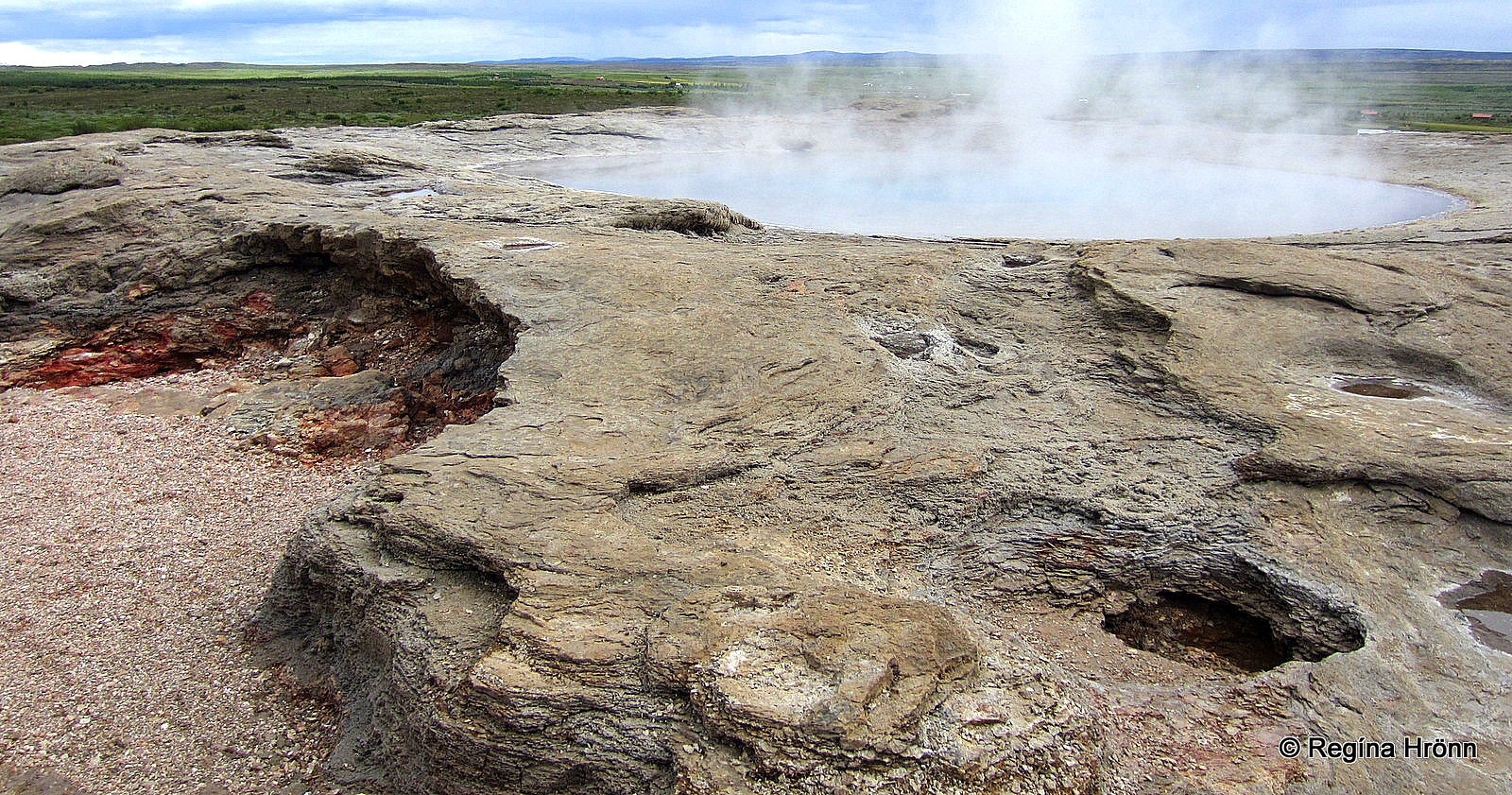
A huge amount of geyserite surrounds the Geysir bowl
Geysir was at its most active following these big earthquakes in the south, and it was apparently very active following the earthquake in 1630. Following these earthquakes, new hot springs emerged and others disappeared in the Geysir geothermal area.
There were other big earthquakes in 1789 and 1896 (we think that there were 5 big ones that year) which changed the geothermal area and the frequency of Geysir’s eruptions.
These big earthquakes are called Suðurlandsskjálftinn – the South-Iceland Quake, and they happen at an approximately 100-year-interval, the last one shaking South Iceland back in 2008 (6.3 on the Richter scale).
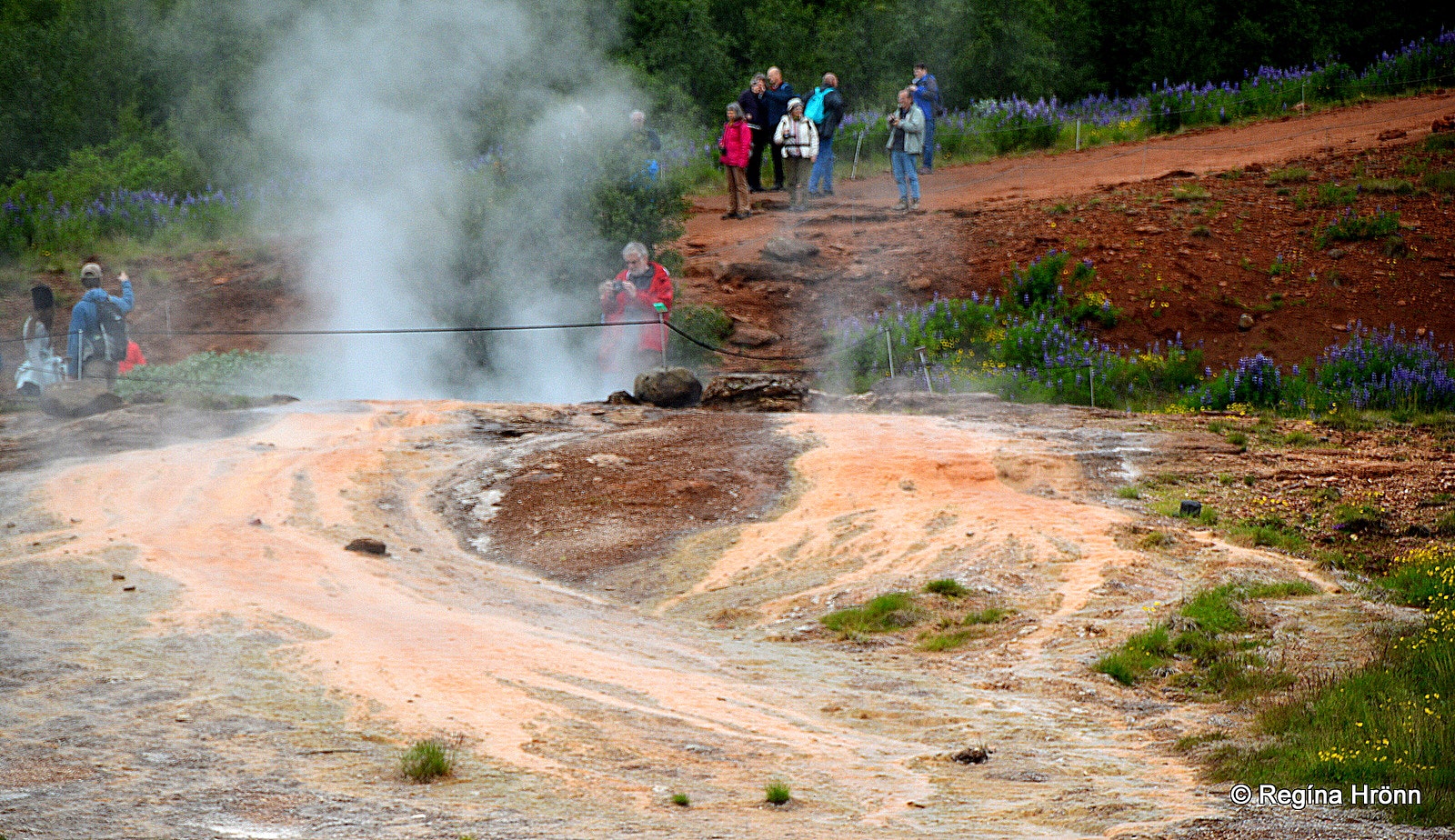
Geysir is very colourful as seen from the east side with beautiful peach and white geothermal colours
On the 17th of June 2000 (our National day), we had a big earthquake, and another one on the 21st of June, 6.5 on the Richter scale; and Geysir started erupting again on average 3 times a day for some period of time.
These earthquakes sometimes come in pairs and a pair of earthquakes shook South Iceland as well back in 1912.
We, who live in this part of Iceland, dread these Suðurlandsskjálfti earthquakes. When I was a kid we often passed by Mt. Ingólfsfjall and my grandparents and parents always used to mention that the big earthquake was due, scaring the living daylights out of me.
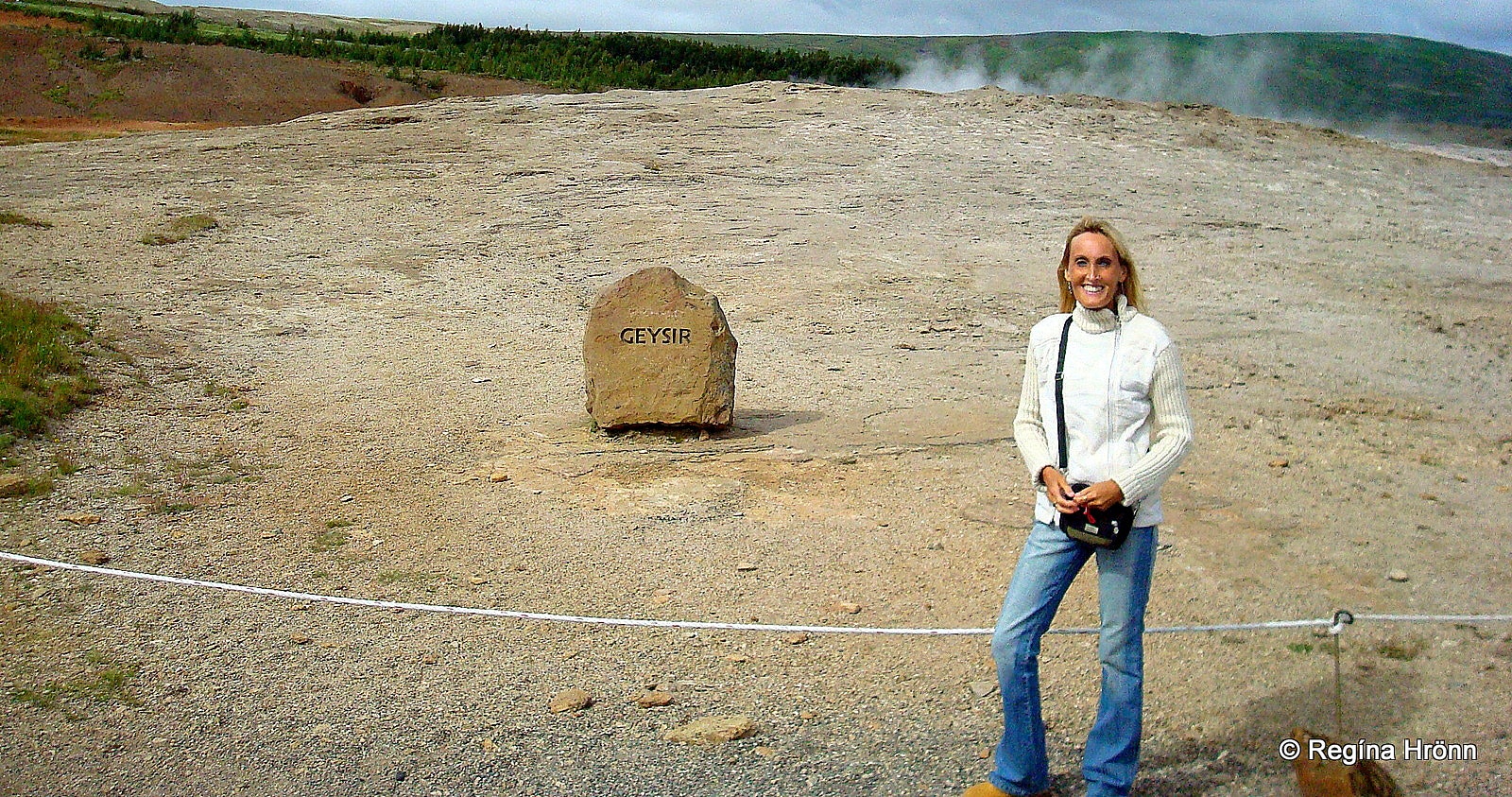 By Geysir
By Geysir
But it so happened that the epicentre of the 2008 earthquake was right beneath Mt. Ingólfsfjall.
When you pass this mountain in the south you will see big boulders which have rolled down the mountain hills during such earthquakes.
See also:
The Viking Settler Ingólfur Arnarson, Mt. Ingólfsfjall and Ingólfsskáli Turf Longhouse in South-Iceland
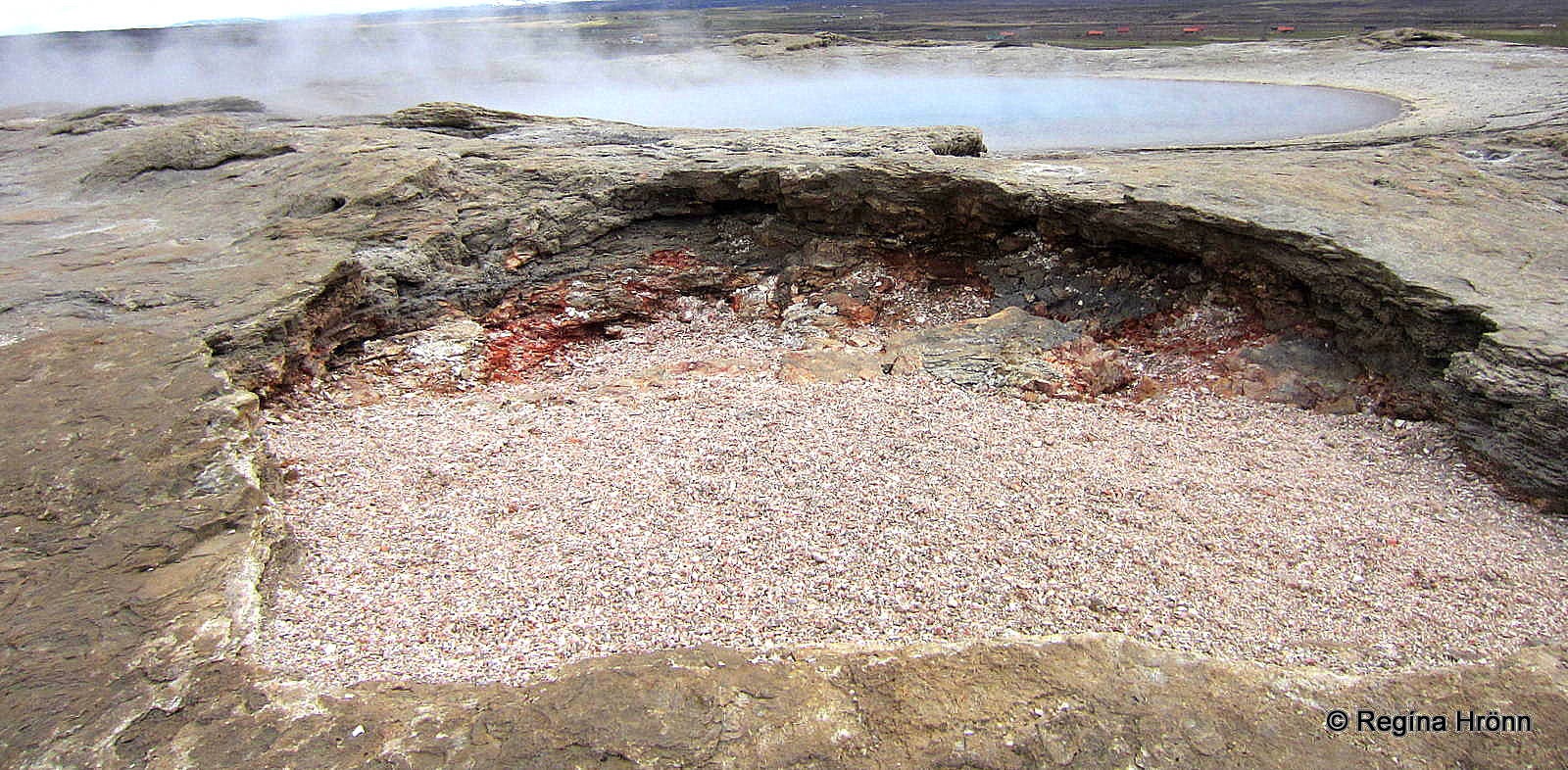
The brittle geyserite has broken here
Geysir slowly stopped erupting after the turn of the 20th century and became dormant after 1916. In 1935 a furrow was made in the bowl to lower the water level which made it erupt again until 1950. The split then got filled by sinter with time.
Then in August 1981 a well-known Icelandic filmmaker, Hrafn Gunnlaugsson, my husband’s second cousin, opened the furrow, as he wanted Geysir to erupt for one of his films “Okkar á milli í hita og þunga dagsins”.
Remember, that technology wasn’t as advanced back then, so a real eruption was needed for the filming.
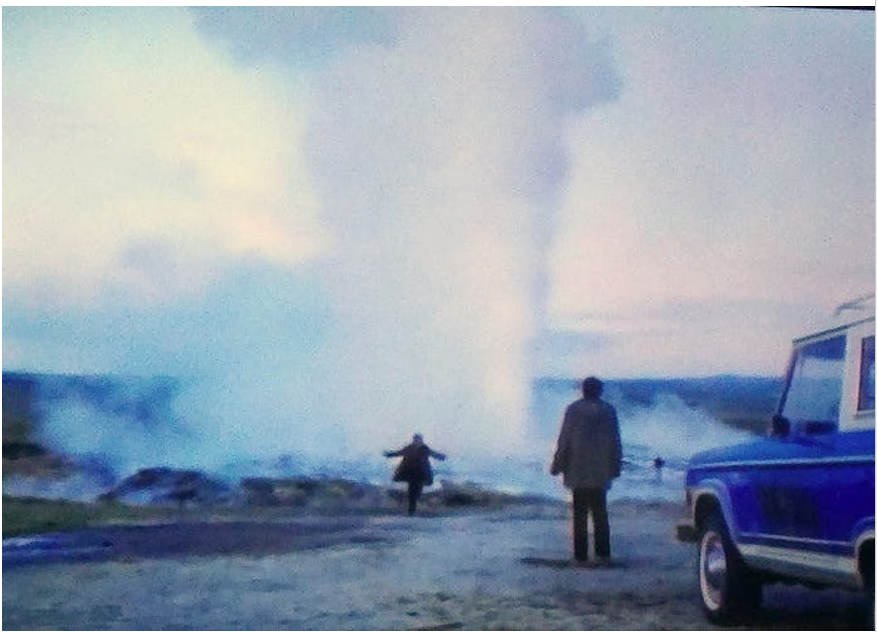 I took this photo of the telly when I last watched Hrafn’s film – it is grainy but serves its purpose
I took this photo of the telly when I last watched Hrafn’s film – it is grainy but serves its purpose
Hrafn talked to the farmers at Geysir, reopened the furrow and enlargened it. This was not well regarded as the furrow was thought to be unsightly, but Geysir started erupting again.
Geysir and the geothermal area was not protected but are on the Nature Conservation Register. On the 17th of June 2020 – our national holiday, the Geysir geothermal area was finally protected.
On big occasions, such as for royal visitors and Verslunarmannahelgin long weekend, the furrow was opened or 40 kilos of soap were put into the bowl forcing an eruption. But that stopped in 1992.
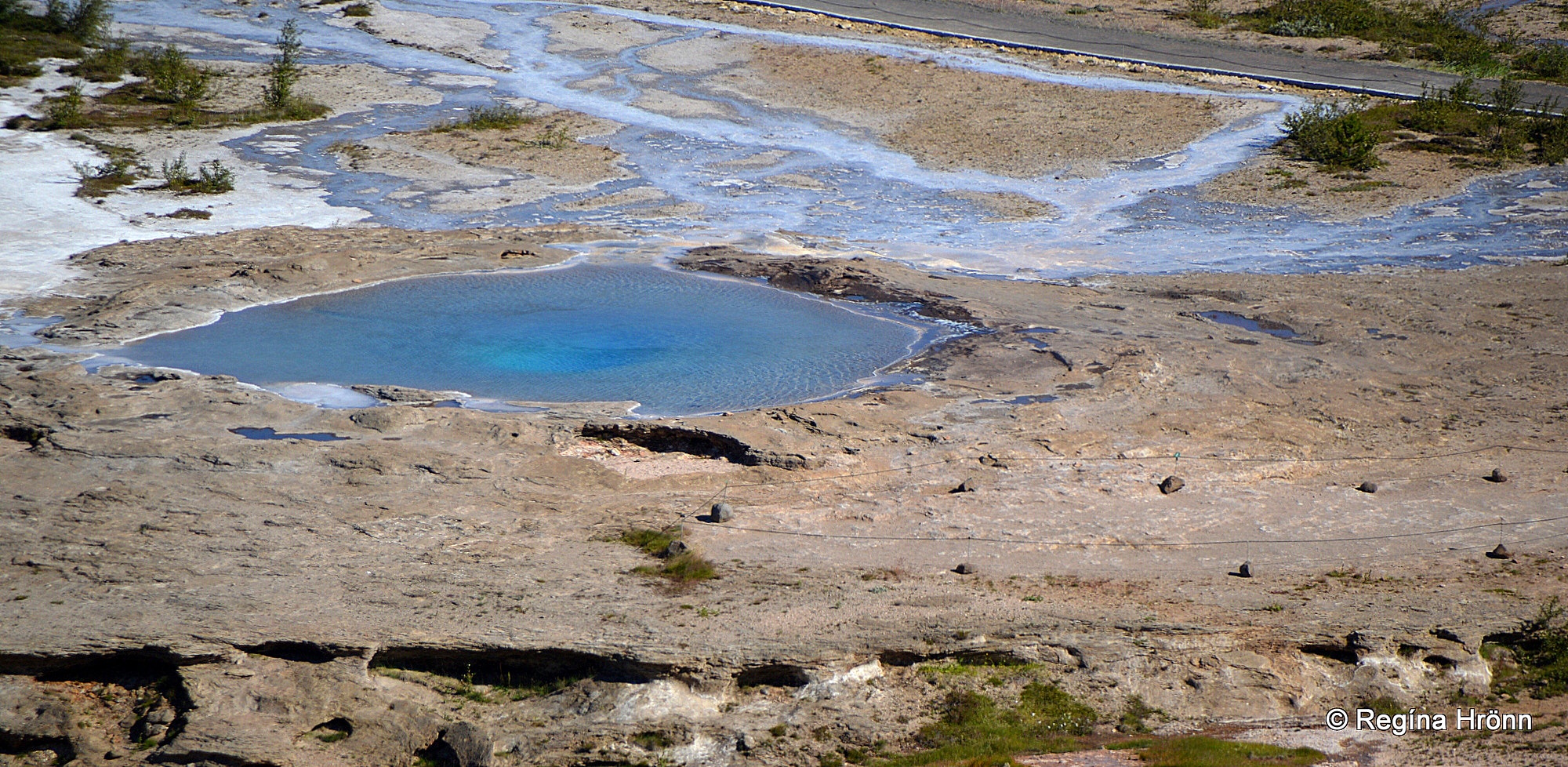 Geysir hot spring
Geysir hot spring
Geysir was a big attraction in Iceland and foreigners would travel to Iceland to see this strange phenomenon. I have read several Icelandic travel journeys from the 18th and 19th centuries written by foreign travellers to Iceland.
And they especially came to Iceland to see Geysir erupt. They didn’t seem that interested in the majestic Gullfoss waterfall while staying in this area, just Geysir and Þingvellir.
Back then Europeans didn’t know much about other spouting geysers in the world. And together with the Yellowstone Park geyser, Geysir is the most famous geyser in the world.
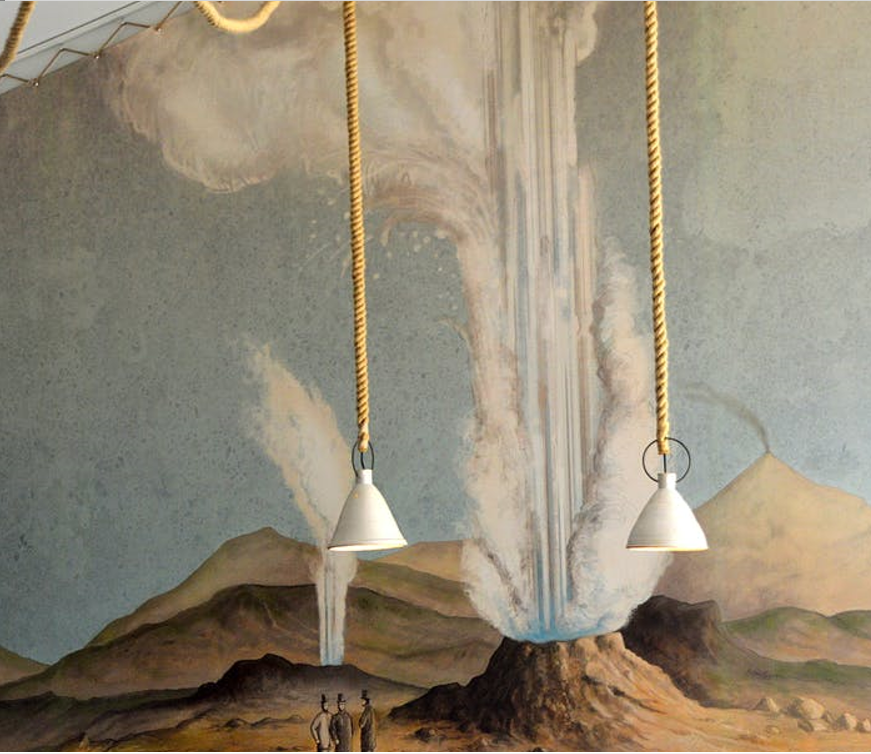 You will find this old painting of Geysir and Strokkur erupting in one of the restaurants at Geysir
You will find this old painting of Geysir and Strokkur erupting in one of the restaurants at Geysir
We have of course no photos from this time, but drawings were made of this spectacular phenomenon. Some of the travellers waited for days to see Geysir erupt, and camped in the geothermal area. Amongst them were Napoleon (nephew of Napoleon Bonaparte) and his entourage who visited this area back in 1856.
Back then there were no roads and few bridges and these foreign guests would have to hire a guide and travel on horseback, so it would take them a couple of days to reach this area.
Þingvellir, the old parliament of the Vikings, was also a big attraction on the way to Geysir and many would stay for the night at the vicarage there.
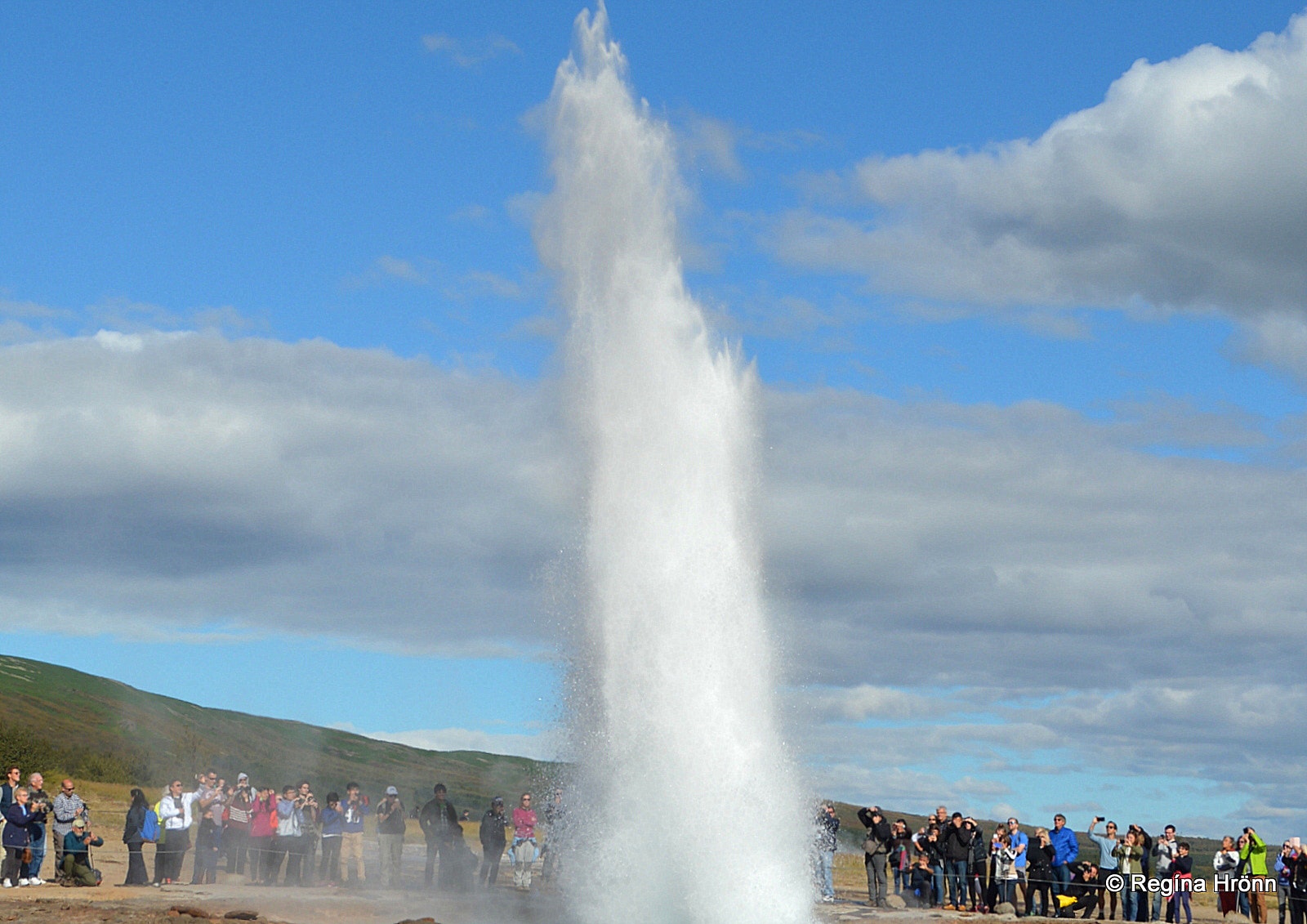 Strokkur erupting
Strokkur erupting
When Geysir erupted back then it must have been a sight to see as it erupted around 60 metres into the air, sometimes even more and sometimes less! And Strokkur also had some majestic eruptions.
Loud thumps are heard before Geysir erupts. In December 2008 after the last big earthquake, a British couple was in grave danger and had to run away from Geysir as it was erupting.
By chance, an Icelandic tour guide was passing by and recognized that the thumps were an indication of a Geysir eruption and could warn them in the nick of time.
I took this photo below back in June 2008, a month after the big earthquake. Then it had not yet been completely fenced off and unsuspecting tourists were standing right next to the bowl, looking into it!
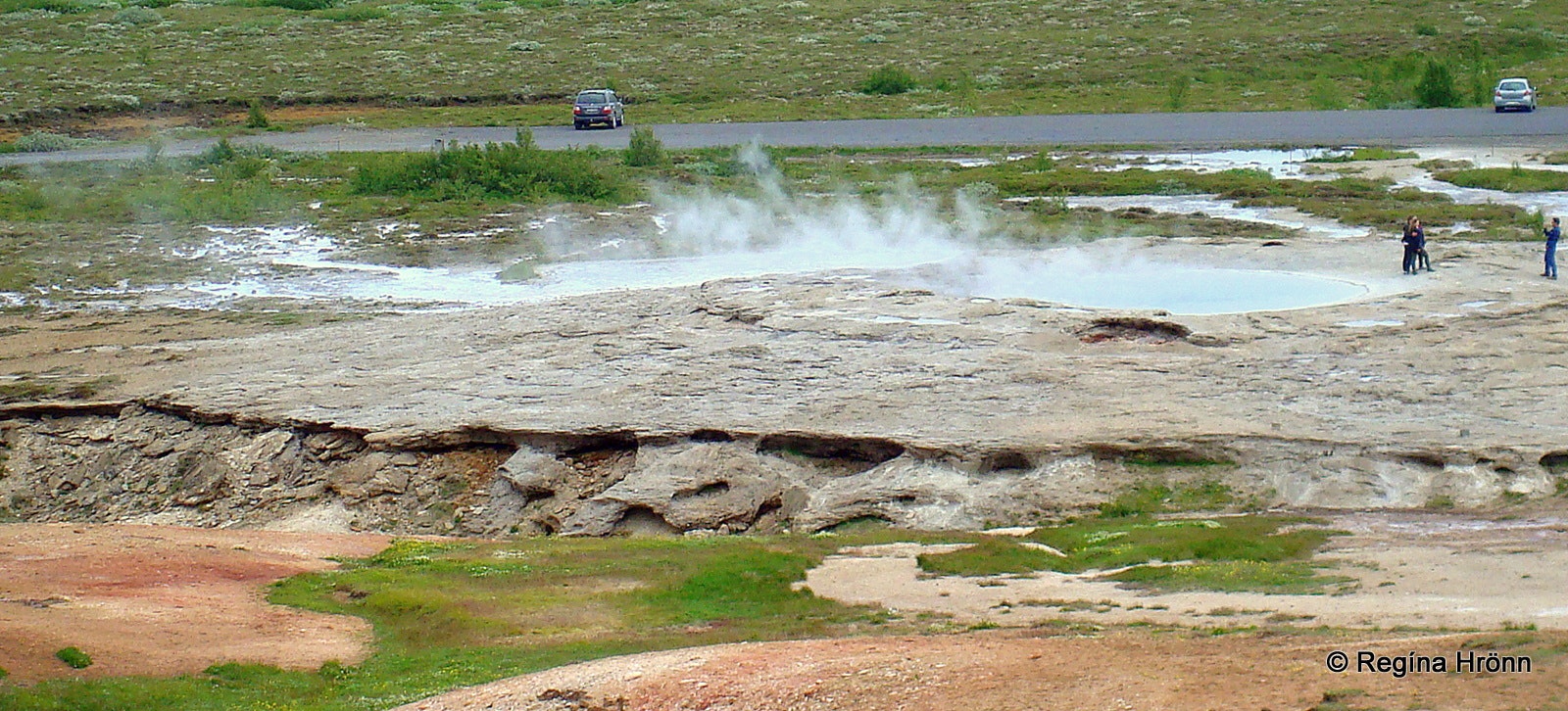 Geysir back in 2008 before it was completely fenced off
Geysir back in 2008 before it was completely fenced off
After that last Suðurlandskjálftinn earthquake, there was no knowing when Geysir would erupt.
I was standing further up in the Geysir geothermal area by Konungshver hot spring, praying that it would not erupt when the tourists were standing on top of it.
You can also see in the photo that the brittle geyserite had not yet broken as much as in my other photos of Geysir.
A Geysir eruption was caught on video back in 2016:
Rare eruption of Iceland’s most famous hot spring Geysir
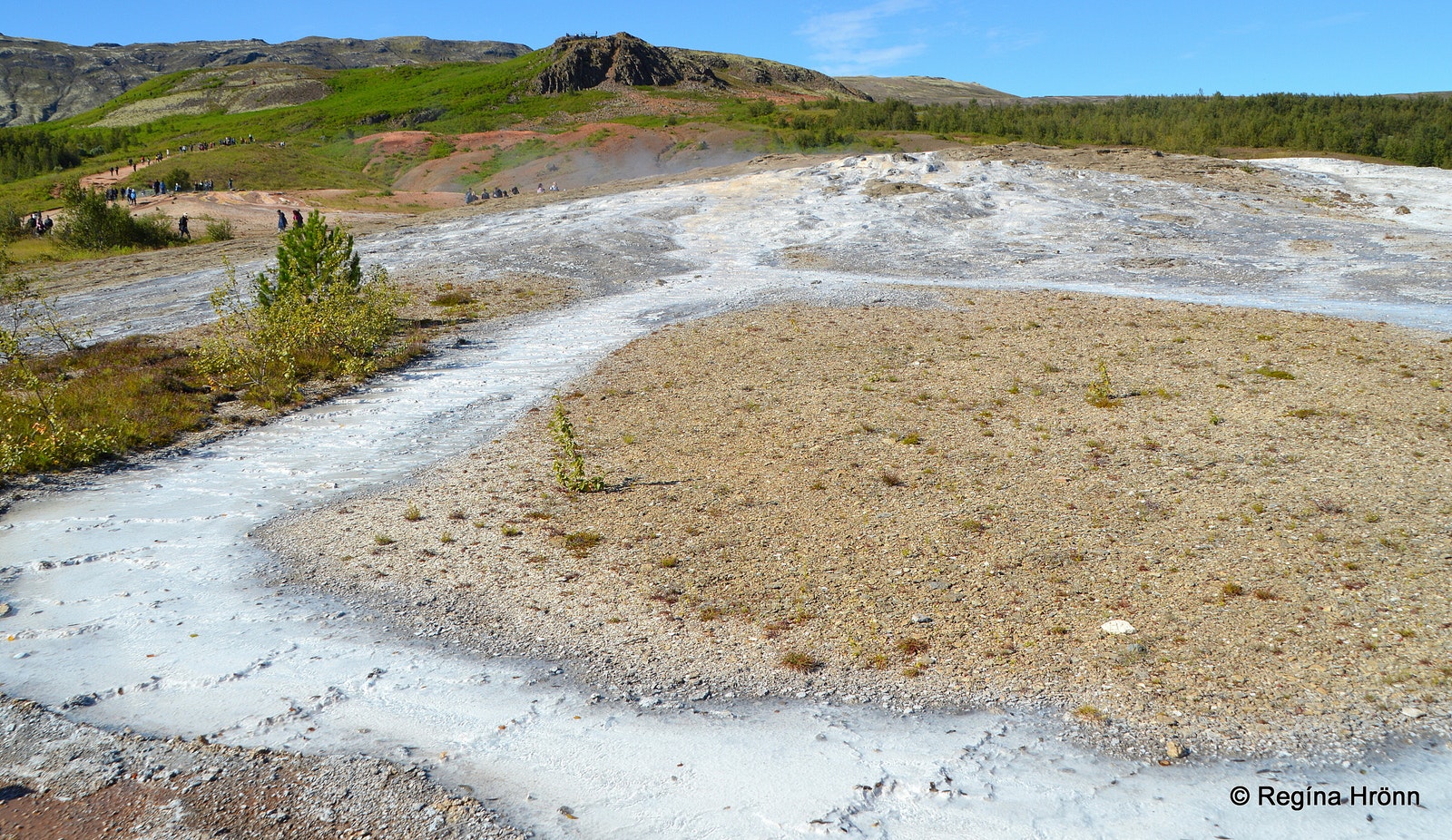 Geysir in 2022
Geysir in 2022
Geysir now only erupts from time to time and has been fenced off, but you can walk very close to it.
I have visited the Geysir area many many times and have never seen Geysir erupt. I would absolutely love to see it though.
Strokkur – the Churn
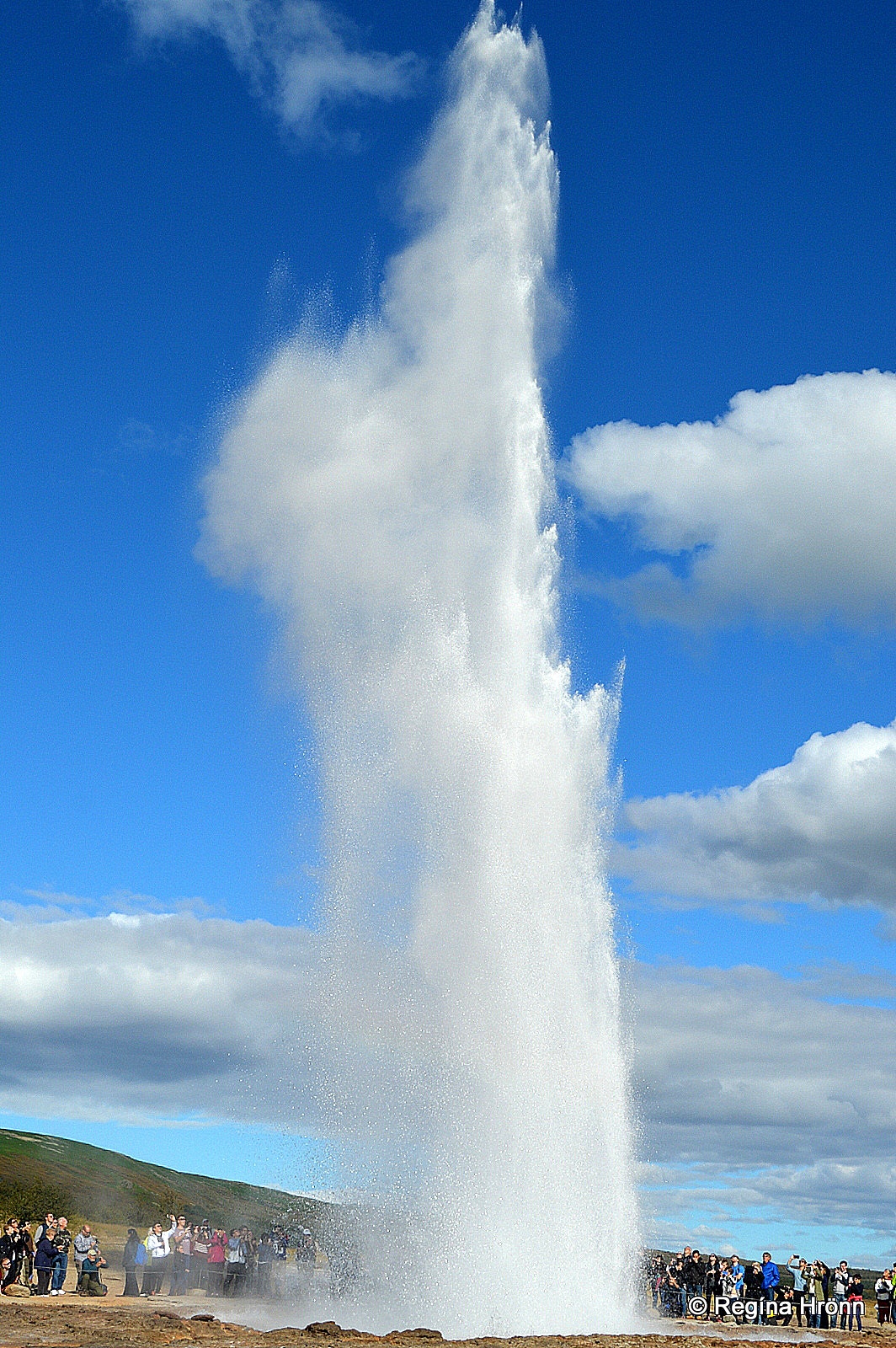 A big eruption in Strokkur
A big eruption in Strokkur
Strokkur is the main attraction at the Geysir geothermal area, since Geysir all but stopped erupting. This spouting hot spring got formed in a big earthquake back in 1789 and was active until 1896.
It erupts now with approximately an 8-minute interval some 25-35 m into the air. But that can change and I have seen it surprise me and erupt when I was totally unprepared, and then erupt again.
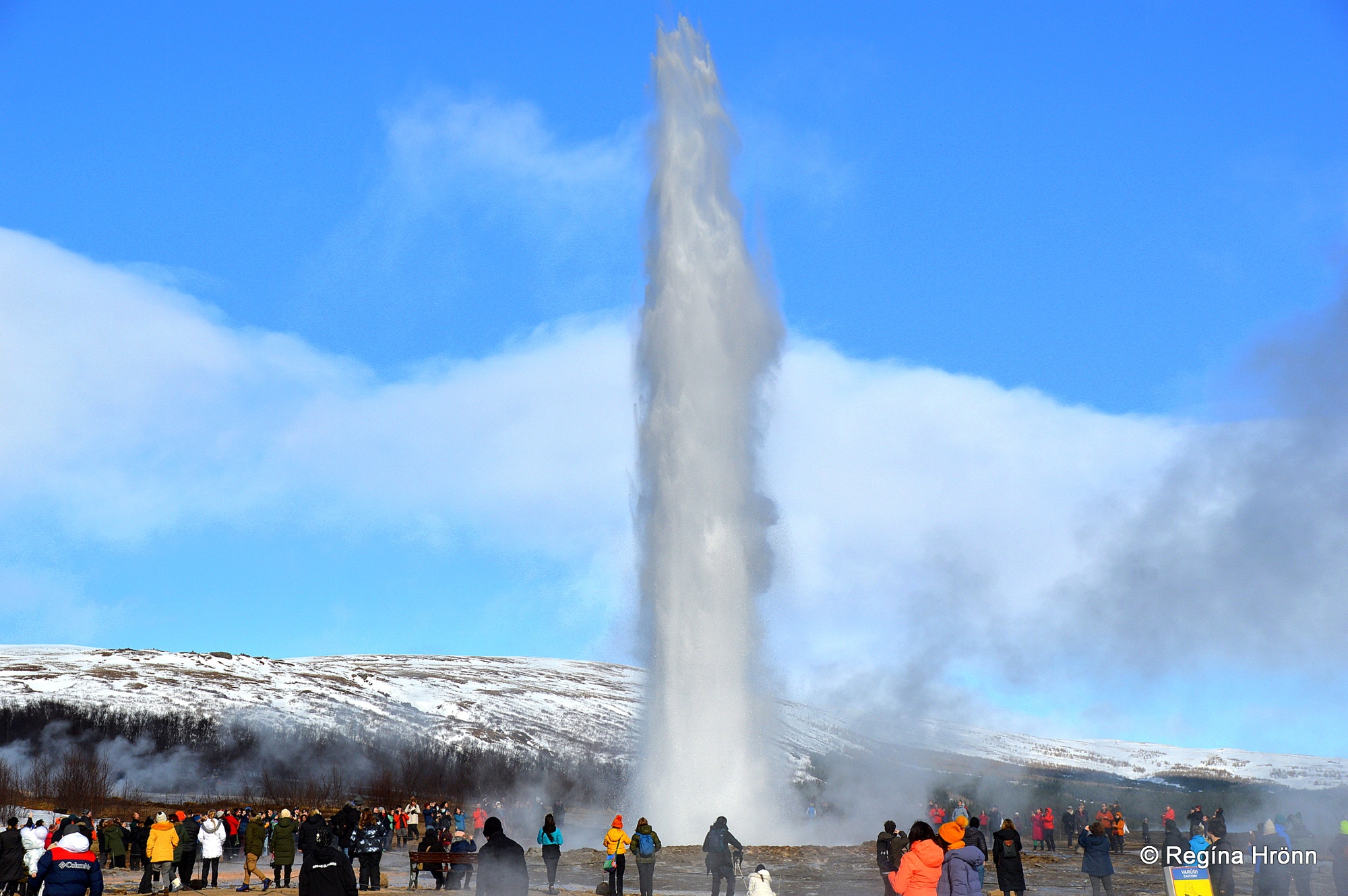 Strokkur in March
Strokkur in March
And it can be a really small eruption or a magnificent one. If it is a small one then I have heard murmurs of disappointment from other travellers 😉 But this is nature and not a show so nothing is certain here.
The name Strokkur means Churn, like in the old instrument for churning butter, and stems from the shape of its shaft.
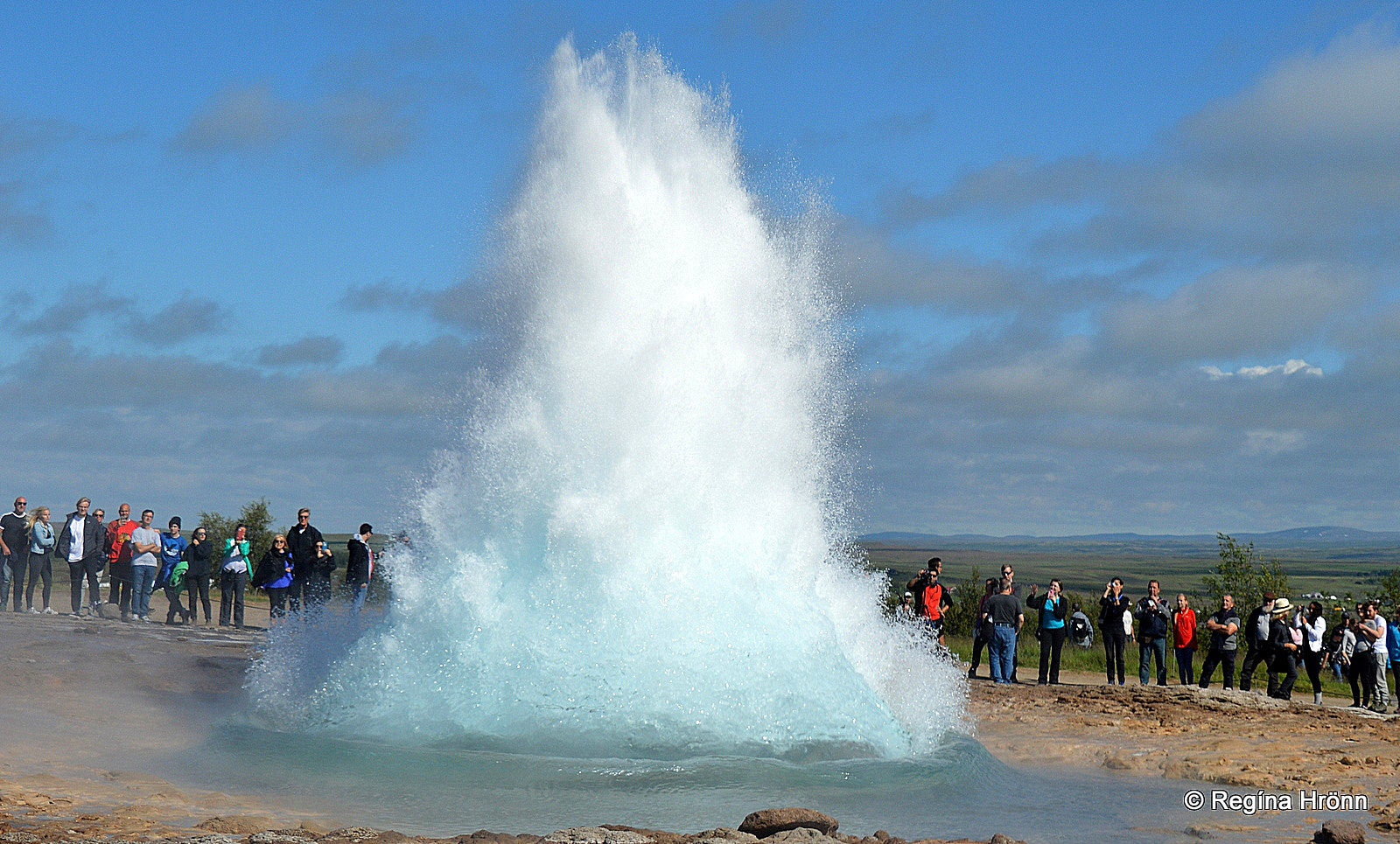 A smaller eruption in Strokkur
A smaller eruption in Strokkur
I also read in an old travel journal, “Íslandsferð J. Ross Browne 1862” that it was called the Churn as it returned everything that was put into it (turf and stones) after churning it.
But it was a common practice “back then” to throw turf into the hot springs to make them erupt. In this book, they put more turf into Strokkur than was the normal amount and Strokkur went amok to try to get rid of it.
When turf was thrown into Strokkur the water spouting in the air turned black!
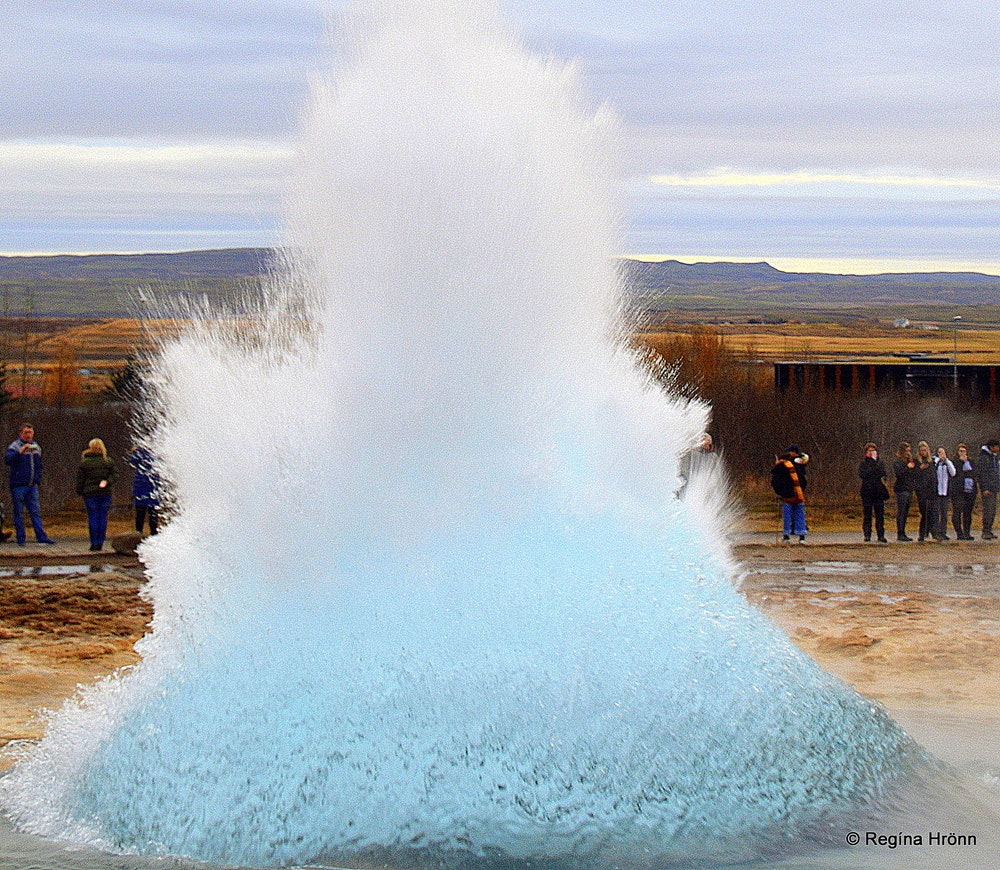
The Strokkur bubble – it is really difficult to photograph in focus
When Strokkur became almost dormant for decades after an active period, measures were taken to clear out the shaft and revive it again, and 40 m were drilled into the shaft.
This was back in 1963 and it has been erupting regularly since.
The way things work here is that this is an active geothermal area with an underground plumbing system, so to speak. Pressure builds up when water comes into contact with a hot basement or bedrock, it heats up and the result is a beautiful eruption.
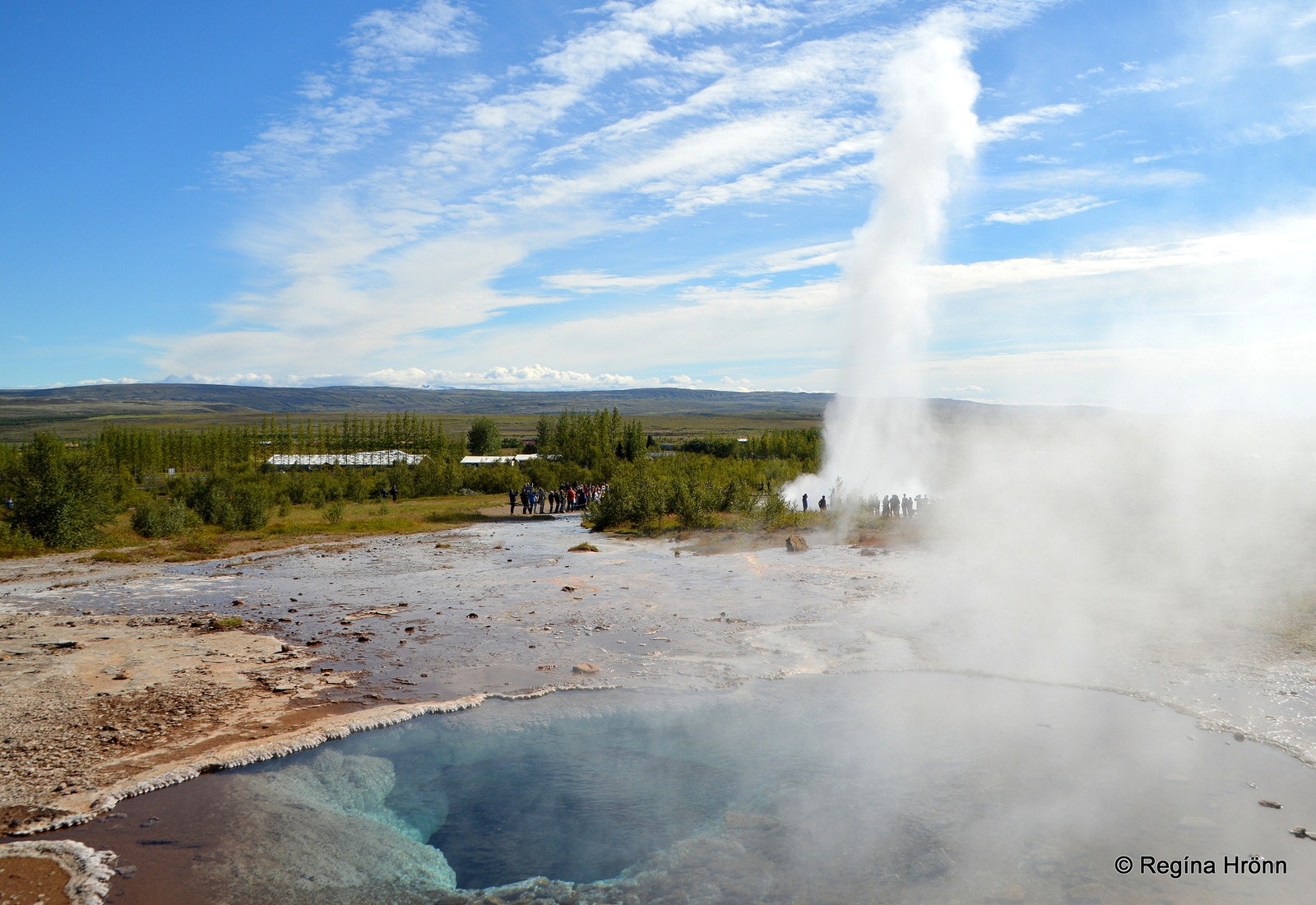 Blesi and Strokkur erupting
Blesi and Strokkur erupting
The hot springs don’t have the strong overwhelming smell of sulphur like the mud pots in so many of the other geothermal areas I have visited on my travels in Iceland.
See also:
Mývatn in North-Iceland – Part IV – Mt. Námafjall, Krafla & Leirhnjúkur Geothermal Areas
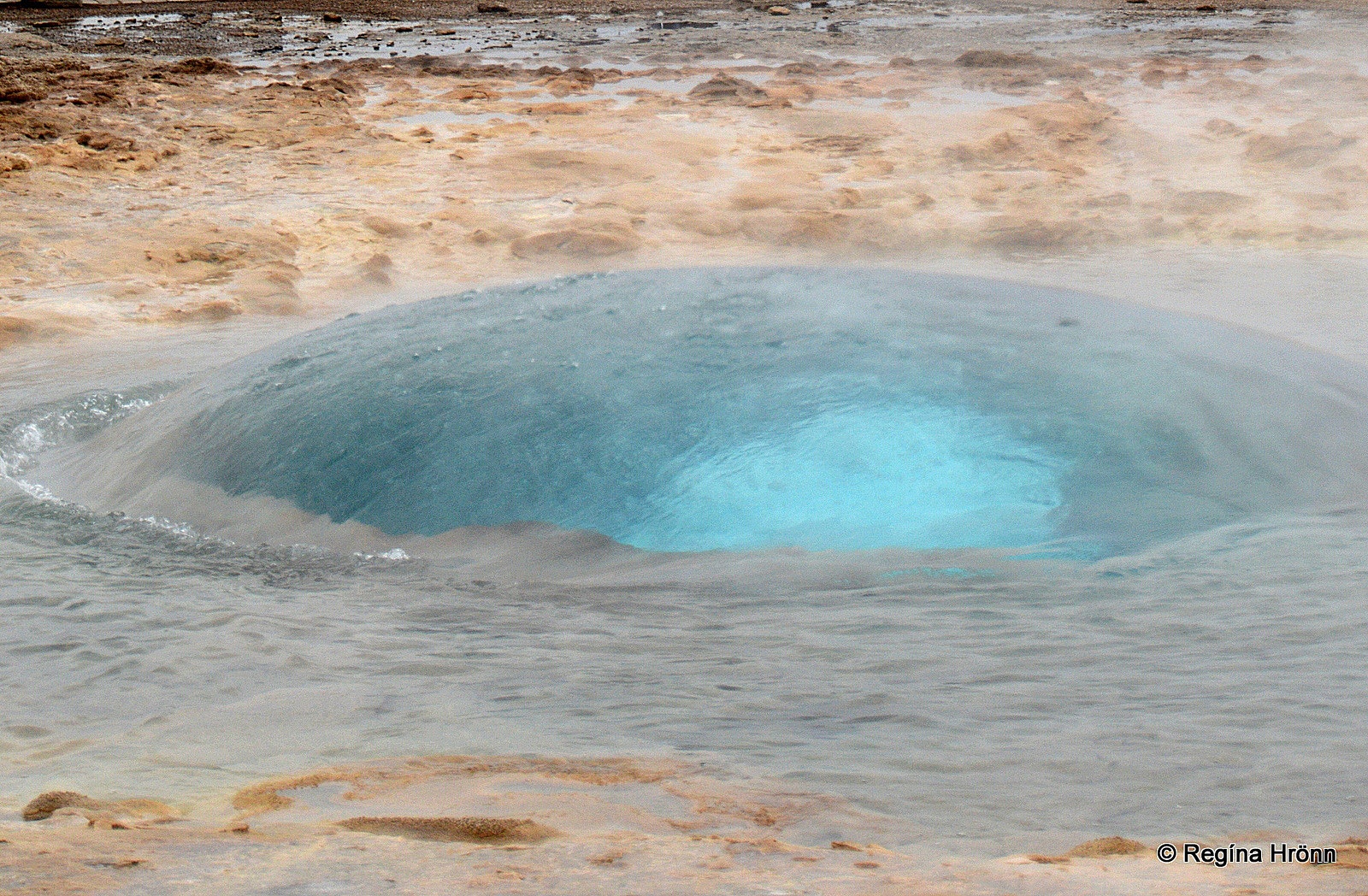 The blue bubble appears, about to burst
The blue bubble appears, about to burst
When you visit the Geysir geothermal area you will see crowds around Strokkur awaiting its next eruption.
I always join the crowd, but it can be tedious standing with your camera ready to catch the eruption on film, as Strokkur erupts on average every 8 minutes.
Keep your eyes on the bowl because it shows some signs prior to an eruption. I have stood here in all kinds of weather, once in -10 degrees C and wind freezing my butt off 😉
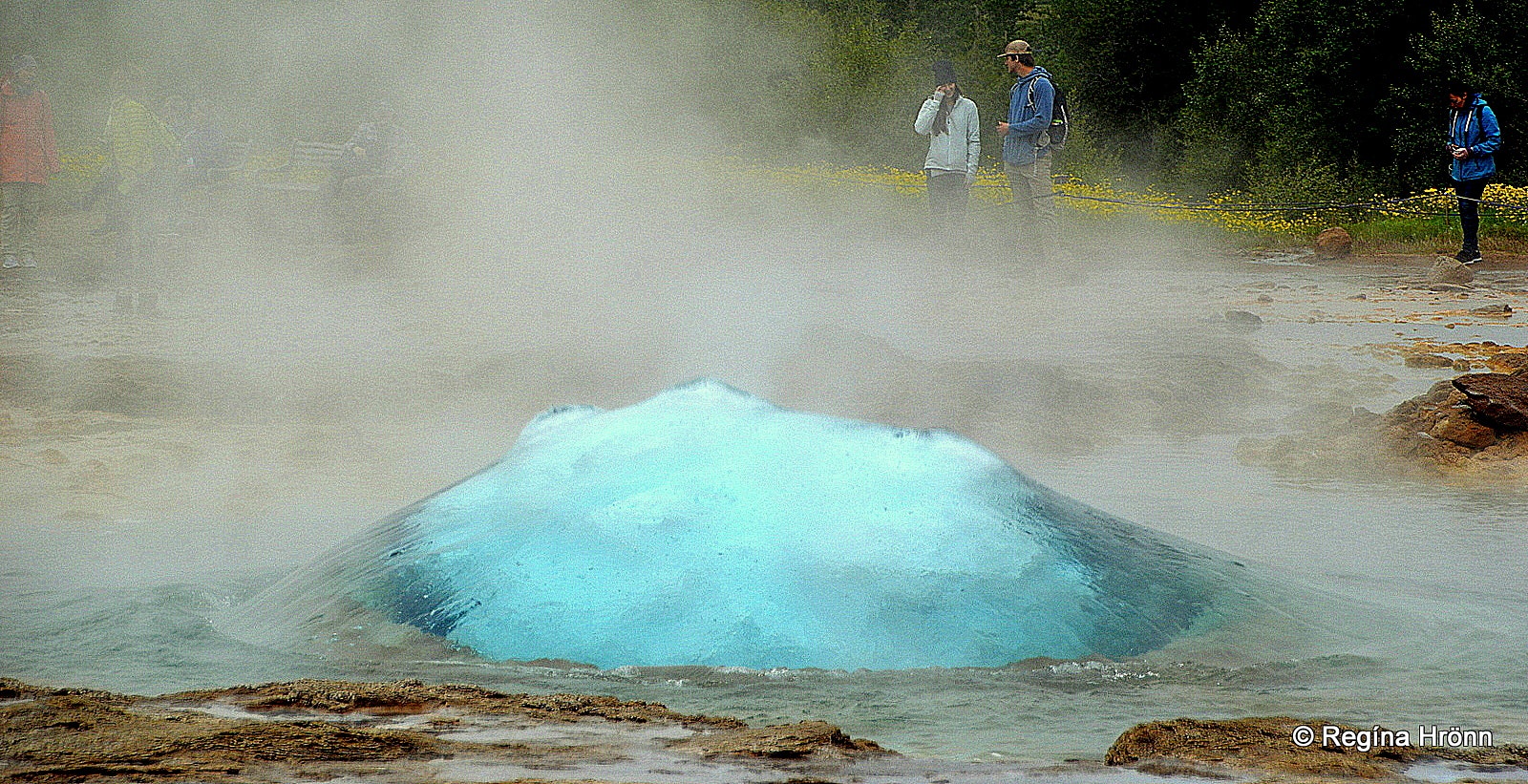 Out of focus, but still cool
Out of focus, but still cool
What I like to do the most is to stand north of it and try to catch a photo of the bubble.
That is pretty difficult and if you press the button too soon or too late then you have to wait for the next eruption.
And I have got so many photos from failed attempts. I must remember to put it on multiple images next time around.
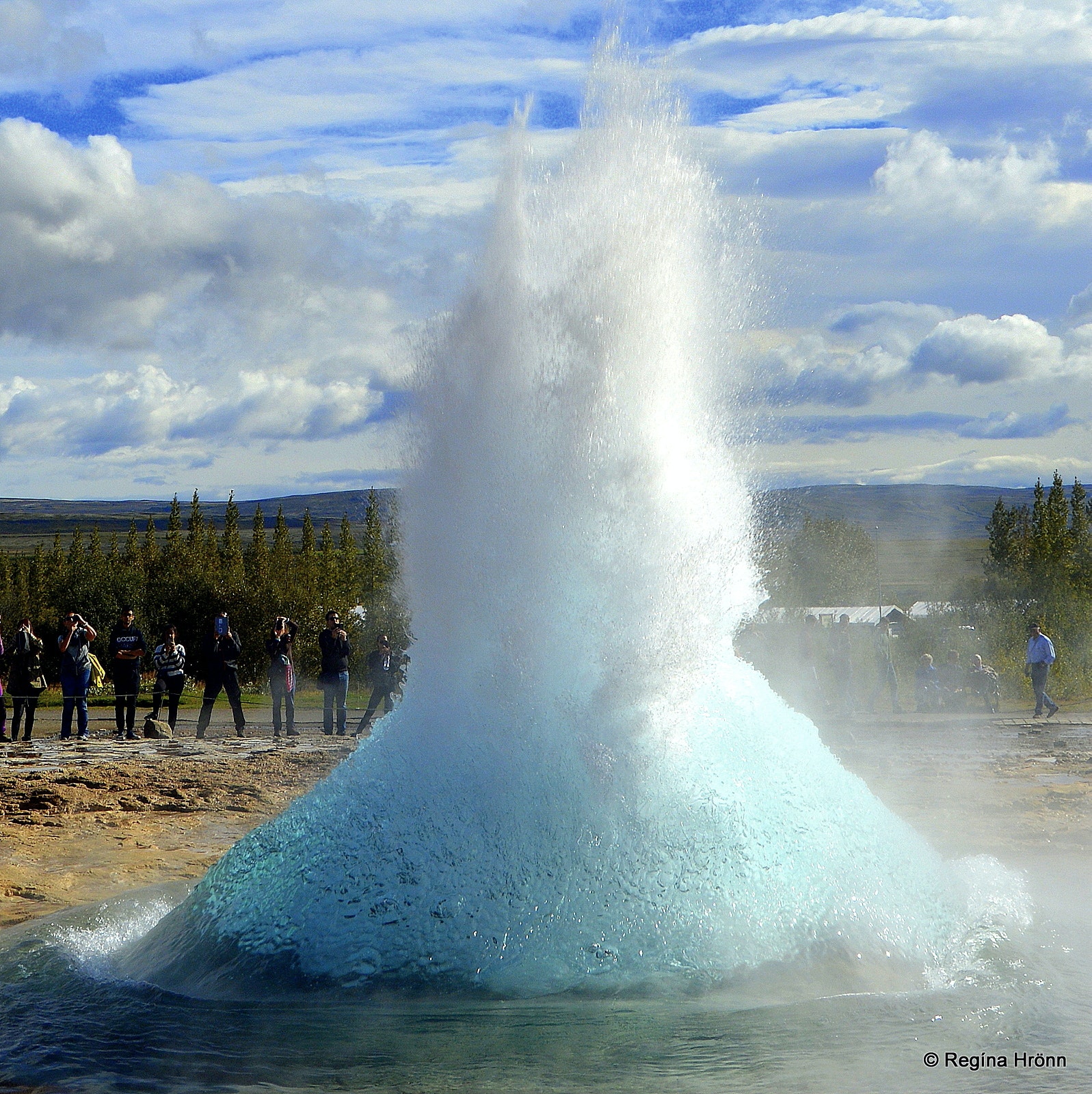
This is my favourite shot of the bubble bursting
Once I was walking upwind of Strokkur when it erupted and I got engulfed in the steam with drops of water landing on my head.
Take that into account when you take your place in the crowds by Strokkur and check from which direction the wind is blowing. I was fortunately too far away for the water to burn me.
See my chapter on “Dangers in geothermal areas” for further information on people who weren’t as lucky.



